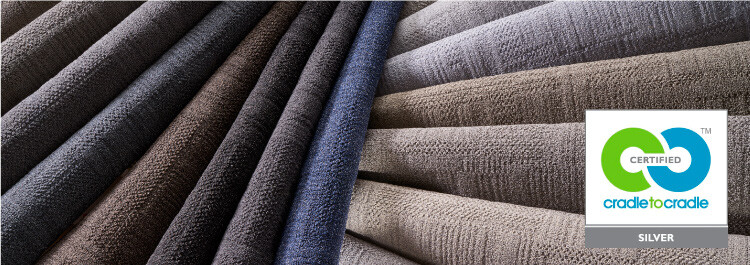First, a big announcement: All Milliken modular carpet in the Americas, Asia and Australia/New Zealand is now Cradle to Cradle CertifiedTM Silver. We have chosen to make a strong commitment to Cradle to Cradle certification because of its well-known status as a recognized and trusted standard across the globe.
With Cradle to Cradle certification (often referred to as C2C or C2C Certified) you’ll notice similarities to other standards you might be familiar with, but also some obvious differences. This felt like an opportune time to have a look at what makes C2C tick.
A CRUCIAL DISTINCTION
When you think about Cradle to Cradle CertifiedTM in comparison to programs like LEED®, or The WELL Building Standard®, here’s the key: Both of the latter two are building standards. Cradle to Cradle is a product standard. There are no C2C Certified spaces or companies, only C2C Certified products. Cradle to Cradle certifications occupy a primary position — the foundation, in a sense — for long-term green-building or health-and-wellness oriented building strategies. C2C Certified products are a sensible starting point if you’re working toward LEED or WELL certified spaces.
We realize it can be really difficult to keep all these standards straight. But once you’re clear about this fundamental distinction — product vs. building —the fog will start to lift.
WHAT’S IT ALL ABOUT?
On their website, the Cradle to Cradle Products Innovation Institute — the organization who administers the standard — describe C2C Certified as having been created to provide “designers and manufacturers with criteria and requirements for continually improving what products are made of and how they are made.” Pay close attention to both parts of this sentence.
Certainly, Cradle to Cradle certification is designed to bolster material transparency and promote the use of safe, healthy, chemical ingredients in the products people use. That’s a fantastic goal, and it’s one that deserves our support. But equally interesting is the way C2C Certified insists and codifies moving past a singular focus on what (“what’s in this thing?”) and get to how (“how was this thing made?”). How is important, because it reveals a long-range, big-picture viewpoint. It goes beyond looking only at the effects a finished product may have on the people who use it, or live next to it (which, let’s be perfectly clear, is a very worthwhile thing to be looking at). But C2C is also concerned with the people who are doing the making, and what’s happening before the product is finished.
There are always catchwords and phrases in vogue — and because they’re trendy you hear them constantly. They become background noise. But — if you think about it for a minute, the C2C what/how certification approach we’ve been talking about is actually a pretty accurate definition of the word holistic.

HOW DOES IT WORK?
Let’s say you’ve determined that a product is appropriate for Cradle to Cradle certification. By proceeding, you’ll be moving along a path of continuous optimization. That’s one of the strengths of C2C Certification — the process itself works as a catalyst for product improvement.
The first step is to select an accredited assessment body to test, analyze and evaluate your product and processes. Milliken partnered with MBDC — the original creators of the Cradle to Cradle Design™ framework — to analyze current practices and identify areas in need of improvement. An Assessment Summary Report was submitted to the Cradle to Cradle Products Innovation Institute (the independent third-party who administer the standard). The Summary Report was thoroughly reviewed and ultimately approved — after which the Institute issued the final certification decision and added the products in question to the Cradle to Cradle Certified Product Registry.
HOW IS IT ORGANIZED?
C2C certification is divided into a five-category structure, and also has five levels of certification. Levels begin at Basic, moving up through Bronze, Silver, Gold, and finally Platinum. Categories are Material Health, Material Reutilization, Renewable Energy, Water Stewardship, and Social Fairness. It turns out some of the most difficult hurdles for manufacturers working through the Cradle to Cradle certification process fall under the first of the five categories. Let’s have a look at them. They are:

MATERIAL HEALTH
This category ties in nicely with the rising interest in material transparency. You want to know what’s in the products you’re buying or standing on. Which is a perfectly reasonable thing to want to know, and Cradle to Cradle certification is in large part about making sure you do. The building standards we noted earlier also get at some of the same issues — in LEED v4 there’s a Materials & Resources Credit (with Cradle to Cradle Certified products specifically noted, and worth additional points), and both WELL v1 and v2 include features promoting Material Transparency. The ILFI’s Declare program is another player in the transparency arena — one Milliken uses and strongly supports.
C2C certification requires that all materials at concentrations higher than 100 parts per million be catalogued. There is an Assessment Rating system which categorizes the component chemicals into categories ranging from Ideal to Banned. Any chemicals from the Banned List (PVC, for example, since we’re talking about modular carpet) preclude the product from receiving Cradle to Cradle certification. The other categories vary with regard to what’s allowed — in some cases a component chemical will be acceptable, in others optimization will require them to be phased out. One of the ways to raise your certification level is to optimize ingredients — so by phasing out certain chemicals, a manufacturer can move from Bronze to Silver, or Silver to Gold.
At Milliken, this category of the Cradle to Cradle Certified Products Program aligns closely with our own approach. C2C Certified encourages material optimization — the use of healthier chemical component ingredients ultimately getting you a higher certification level. That’s what an effective standard should do: create incentives to make healthier products. C2C does exactly that.
MATERIAL REUTILIZATION
Recycling is probably the first thing people think about when they see this category, but actually it’s just one part of the Cradle to Cradle Certified formula. We say formula because there literally is one: Material Reutilization Scores are calculated based on the percentages of a product’s component ingredients which are, 1) rapidly renewable or use recycled content, 2) can be safely reused, recycled, or composted, and 3) can be designated as “technical” (meaning they can be returned to industry) or “biological” (meaning they are safe to return to nature).
By determining how a product fares using these criteria, a score is calculated to determine the certification level for the Material Reutilization category. Higher is better, with Platinum requiring a score of 100, while Silver is granted at 50, Gold at 65. Top scores can only be achieved with full product recovery and cycling — but there are various combinations of sustainable attributes that can be used to attain Bronze, Silver or Gold. Manufacturers make their own choices about how far to go with a product, and the optimal way to get there.
RENEWABLE ENERGY
This is a straightforward category intended to encourage the use of clean, renewable energy. Carbon credits also play a part in the certification level. Basic certification looks simply at controlled levels of emissions, while a strategy for carbon management and renewable energy can get a manufacturer to Bronze. Higher levels require verifiable percentages of renewable sourcing or offsets, along with offsets for emissions — Silver, for example, sets the levels at 5% for sourcing and emissions, while for gold the percentage jumps to 50.
WATER STEWARDSHIP
At first glance, one might assume this category is geared toward saving water. But in truth, C2C’s intentions have more to do with what’s going out than with what’s coming in. The Water Stewardship requirements start from Basic — assuring that there have been no significant discharge violations over the prior two years, that effluent management and local water issues are disclosed and characterized, and a commitment to mitigating any problems that have actually arisen. From there, the standard moves up through all five levels to finally arrive at Platinum, which requires that all water leaving the facility where the product in question was manufactured meet drinking-water quality standards — a very high bar.

SOCIAL FAIRNESS
The final category deals with how a business interacts with the community within which it resides. Cradle to Cradle Certified asks for third-party audits to assess workplace conditions. Human resource concerns are considered — hiring practices and the like. C2C looks at a given product’s supply chain and whether there are any issues lurking there. And finally, there are incentives for community involvement — for Platinum level certification an “innovative social project” is mandatory.
From our standpoint, what makes this category so interesting is to think of what it means for the products we buy and use. Let’s say you walk into a store and see a building product you decide to purchase (carpet tile, electrical components, or some type of wallcovering, for example) and you notice the product is labeled Cradle to Cradle Certified Gold. Based on the Social Fairness category, what does that mean? It means the light switches you’re getting were produced at a facility with a solid record of employee satisfaction, good standing in its community — a company that doesn’t discriminate, perhaps a company that built a baseball field for the local little league. The light switches you just purchased come with that story.
Milliken is pleased to produce modular carpeting that is Cradle to Cradle Certified Silver for exactly those reasons. Along with so many of the others mentioned above. We (and thousands of other companies) take a great interest in manufacturing products which look good and work well. But we’re also able to put a little something extra into them. It’s the extra (the what and the how) which we hope will help make the world just a little bit better. One step at a time — we can all do our part.
Cradle to Cradle Design™ is a registered trademark of MBDC.
Cradle to Cradle Certified™ is a certification mark licensed by the Cradle to Cradle Products Innovation Institute.
LEED® — an acronym for Leadership in Energy and Environmental Design™ — is a registered trademark of the U.S. Green Building Council® .
The WELL Building Standard® is a registered trademark administered by the International WELL Building Institute™.







